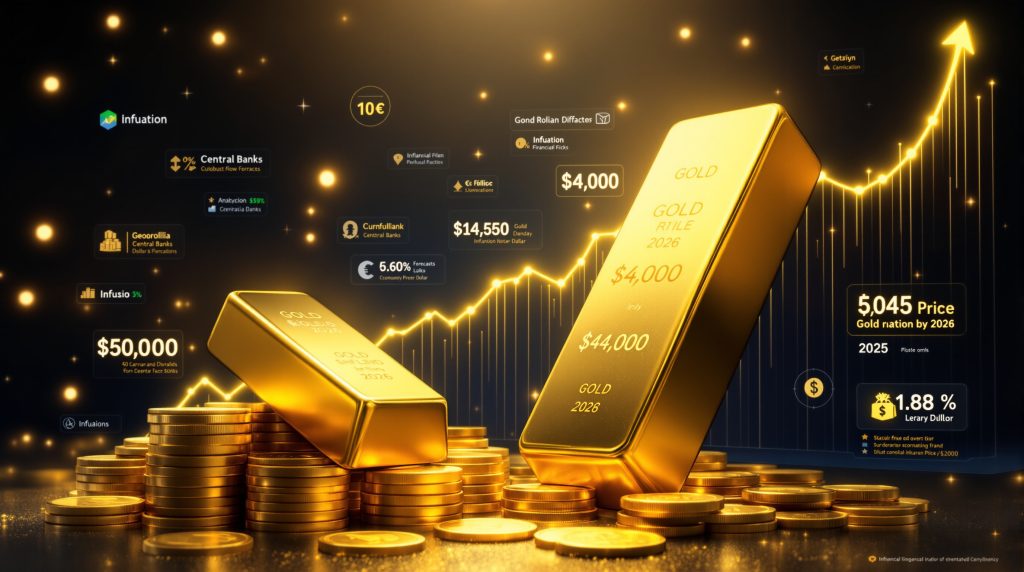What's Driving Gold's Record-Breaking Rally?
Gold prices have demonstrated remarkable momentum in 2024, consistently pushing into new all-time high analysis territory. This extraordinary market performance has compelled major financial institutions to significantly adjust their forecasts upward, with some now projecting gold could reach the $4,000 per ounce milestone by 2026. The precious metal's upward trajectory appears to be accelerating rather than slowing, challenging conventional market expectations.
Key Market Factors Pushing Gold Higher
The gold market's impressive performance stems from a convergence of powerful economic and geopolitical factors creating ideal conditions for precious metals:
- Persistent inflation concerns despite aggressive central bank interventions
- Escalating geopolitical tensions across multiple regions globally
- Central bank purchasing maintaining historically elevated levels
- Eroding confidence in traditional reserve currencies
- Strategic institutional portfolio rebalancing toward tangible safe-haven assets
This perfect storm of supportive factors has created substantial buying pressure from both retail and institutional investors seeking protection from currency devaluation and financial instability. Market participants increasingly view gold not merely as a tactical position but as a strategic long-term holding.
How Accurate Are Banking Forecasts for Gold Prices?
The Conservative Nature of Institutional Projections
Major financial institutions have consistently provided conservative forecasts for gold prices, frequently underestimating potential upside movements. This pattern continues today, with current projections that many market analysts consider overly cautious given the metal's recent price momentum and supporting fundamentals.
Banking forecasts tend to remain conservative for several strategic reasons:
- Institutional hesitation to highlight alternative assets that compete with traditional financial products
- Reluctance to trigger client portfolio reallocations away from managed funds
- Preference for incremental forecast adjustments rather than bold predictions
- Regulatory and reputational considerations associated with aggressive commodity forecasts
These institutional constraints often result in forecasts that trail rather than anticipate market moves, particularly during periods of rapid price appreciation.
Recent Forecast Revisions by Major Banks
Several prominent financial institutions have recently updated their gold price forecast, revealing a pattern of steadily increasing expectations:
| Institution | Previous 2025 Forecast | Updated 2025 Forecast | 2026 Projection |
|---|---|---|---|
| Société Générale | $2,900 | $3,300 | Up to $4,065 (Q2) |
| Bank of America | $2,400 | $3,000 | $3,300 |
| Goldman Sachs | $2,700 | $2,900 | $3,100 |
| Citibank | $2,500 | $2,800 | $3,000+ |
| JP Morgan | $2,300 | $2,650 | Not published |
Société Générale's projection stands out as particularly noteworthy, forecasting gold prices potentially exceeding $4,000 per ounce by Q2 2026. This represents a substantial premium to their previous outlook and positions them among the most optimistic major institutions regarding gold's medium-term prospects.
Is $4,000 Gold Realistic or Conservative?
Analyzing the Pace of Recent Price Movements
The gold market has demonstrated remarkable velocity in recent months, with substantial price increases occurring over compressed timeframes. This rapid appreciation suggests that longer-term forecasts projecting similar gains over extended periods may actually underestimate potential price targets.
For perspective on recent market surge performance:
- Gold has demonstrated the ability to gain $200+ over relatively short periods
- The metal has added substantial value during the past 12 months
- Price consolidations have been brief before resuming upward trajectories
When analyzing the current rate of price appreciation, reaching $4,000 before the conclusion of 2025 appears entirely feasible, suggesting that projections targeting this level in 2026 may indeed be conservative rather than aggressive.
Technical and Fundamental Support Factors
Several technical and fundamental factors reinforce the case for continued strong performance:
Technical Factors:
- Bullish chart patterns showing sustained upward momentum
- Limited significant resistance levels above current prices
- Consistent buying pressure on pullbacks indicating solid support levels
- Increasing volume accompanying price advances
Fundamental Factors:
- Central bank purchasing showing no signs of slowing
- Investment demand rising across both retail and institutional sectors
- Mining supply constraints limiting new production growth
- Declining confidence in traditional fiat currencies globally
The convergence of these supportive technical and fundamental factors creates a powerful foundation for continued price appreciation.
Central Bank Gold Acquisition: The Hidden Catalyst
Official vs. Actual Purchase Volumes
Central bank gold purchases have emerged as a major market driver, though official reporting likely understates actual acquisition volumes. Analysis of customs data and international gold flows suggests that some nations may be acquiring substantially more gold than officially reported through various channels.
This reporting discrepancy becomes particularly evident when examining:
- Direct purchases from non-London Bullion Market Association (LBMA) sources
- Acquisitions through intermediaries and proxies
- Purchases of semi-refined materials for domestic processing
- Transactions conducted through sovereign wealth funds and state enterprises
These alternative acquisition channels allow for substantial accumulation without the transparency required through traditional market mechanisms.
Strategic Implications of Central Bank Accumulation
The accelerated pace of central bank gold acquisition carries profound implications for the global monetary system:
- Diversification away from traditional reserve currencies like the US dollar
- Potential preparation for significant monetary system restructuring
- Strategic hedging against geopolitical and economic uncertainties
- Positioning for potential future currency backing scenarios
This systematic accumulation by central banks represents more than portfolio diversification—it suggests preparation for fundamental changes in the global monetary architecture.
How Tariffs and Trade Policies Impact Gold Flows
Redirecting Global Gold Movements
Recent trade policies, including significant tariffs on gold imports, have dramatically altered global gold flows. Swiss gold exports to the United States reportedly declined by approximately 99% following the implementation of a 39% tariff on certain gold products, while exports to China increased substantially during the same period.
These rapid shifts demonstrate how quickly trade policies can redirect precious metals flows, potentially creating regional price disparities and supply imbalances in key markets.
Price Implications of Altered Trade Patterns
The redirection of gold flows due to tariff policies creates several potential price implications:
- Development of premium pricing in markets facing import restrictions
- Global price increases as acquisition costs rise in major markets
- Acceleration of central bank purchasing to avoid future trade barriers
- Formation of alternative trading channels outside traditional systems
These evolving trade dynamics add another layer of complexity to the gold market, potentially creating additional upward price pressure as normal supply channels become constrained or more expensive.
The Dollar Dilemma: Currency Devaluation and Gold
The External Dollar Problem
A critical yet frequently overlooked factor in gold's potential trajectory is the vast quantity of US dollars held outside the United States. Estimates suggest a significant percentage of all US currency circulates offshore, supporting international trade and serving as record‑high inflation hedge.
This external dollar positioning creates a substantial vulnerability under certain conditions:
- If international demand for dollars declines substantially
- If alternative trade settlement mechanisms gain meaningful traction
- If major holders begin repatriating dollar reserves to their domestic economies
The potential repatriation of these external dollars could create substantial inflationary pressure within the US economy, potentially driving accelerated gold appreciation as a hedge against currency devaluation.
Portfolio Rebalancing by Major Institutions
Major financial institutions have begun reducing dollar exposure in favor of gold and alternative currencies. Some financial institutions have reportedly increased gold allocations while reducing dollar holdings, reflecting growing institutional concern about long-term dollar stability.
This reallocation trend represents a meaningful shift in risk perception among sophisticated market participants with extensive research capabilities and global market visibility.
What Could Drive Gold Beyond $4,000?
Potential Catalysts for Accelerated Appreciation
Several potential catalysts could drive gold significantly beyond the $4,000 level:
- Central Bank Digital Currency Implementation: Accelerated adoption of CBDCs could trigger increased interest in physical assets
- Major Sovereign Debt Crisis: Deterioration in fiscal conditions of major economies
- Geopolitical Escalation: Expansion of existing conflicts or emergence of new tensions
- Significant Dollar Devaluation: Loss of reserve currency status or confidence
- Banking System Stress: Liquidity or solvency concerns in major financial institutions
Any of these scenarios, individually or in combination, could substantially accelerate gold's appreciation beyond current forecasts.
Timeline Considerations
The timeline for potential price targets depends heavily on which catalysts materialize and their intensity:
- Under stable conditions with gradual appreciation: $4,000+ by mid-2026
- With moderate catalyst activation: $4,000 by end of 2025
- With significant catalyst activation: $4,000+ possible within a much shorter timeframe
This range of potential scenarios highlights the importance of monitoring key economic and geopolitical developments that could dramatically alter gold's price trajectory.
Investment Implications: Positioning for the Gold Surge
Portfolio Allocation Strategies
Investors considering exposure to gold's potential appreciation have several investment strategies options:
Physical Ownership:
- Bullion coins and bars (sovereign mints generally preferred)
- Allocated storage programs through reputable providers
- Segregated vault storage for larger holdings
Mining Equities:
- Major producers with strong balance sheets and proven reserves
- Mid-tier producers with attractive growth profiles
- Royalty and streaming companies for reduced operational risk
ETFs and Funds:
- Physical-backed ETFs for convenient exposure
- Mining equity funds for diversified producer exposure
- Specialized precious metals funds with professional management
Each approach offers different risk-reward profiles and should be evaluated against individual investment objectives and time horizons.
Risk Management Considerations
While gold's outlook appears positive, prudent risk management remains essential:
- Maintain appropriate portfolio diversification across asset classes
- Consider phased entry to manage timing risk
- Understand the different risk profiles of physical metal versus mining equities
- Monitor key economic indicators that might signal changes in gold's trajectory
The implementation of sound risk management principles remains crucial even in markets with strong fundamental support.
Disclaimer: This article contains forward-looking statements and projections regarding future gold prices. These projections are based on current market conditions and available information, which may change significantly. Investors should conduct their own research and consider consulting with financial professionals before making investment decisions.
Conclusion: Is $4,000 Gold the Destination or a Waypoint?
The convergence of multiple supportive factors suggests gold's trajectory toward $4,000 per ounce is increasingly probable. However, the timeline projections from major financial institutions may prove conservative given the pace of recent price appreciation and the potential for catalyst activation.
For long-term investors, the key consideration may not be whether gold reaches $4,000, but rather whether this level represents a destination or merely a waypoint in a more extended appreciation cycle. The fundamental drivers supporting gold—currency debasement, geopolitical instability, and central bank diversification—show no signs of abating, suggesting the current bull market may have considerable room to run.
The Société Générale gold price forecast of $4,065 by Q2 2026 may ultimately prove prescient, though market conditions suggest this target could be reached sooner than projected if current momentum continues.
As with any investment decision, individual circumstances, risk tolerance, and investment objectives should guide specific allocation decisions regarding precious metals exposure. Gold's historical role as a store of value during periods of monetary uncertainty continues to attract investors seeking protection against the ongoing debasement of fiat currencies and increasing global instability.
Want to Stay Ahead of Major Gold Discoveries?
Discovery Alert's proprietary Discovery IQ model instantly notifies subscribers of significant ASX mineral discoveries, providing actionable insights for gold and precious metal investors seeking an immediate market advantage. Explore why these discoveries can generate substantial returns by visiting our dedicated discoveries page and begin your 30-day free trial today.




